-
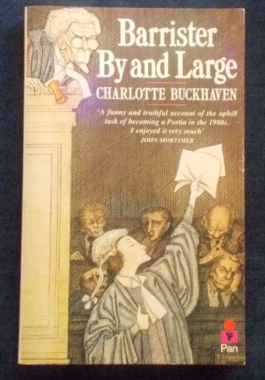 Written in the tradition of James Herriot and Richard Gordon, here are all the wildly funny ups and downs of would-be Rumpole Charlotte Hunter's apprenticeship at the Middle Temple. The Law is an unrelenting taskmaster whose only consistent feature is its infinite capacity to surprise, being full of eccentric characters and the domination of medieval chivalry and male infallibility (!) - and she found herself dashing from one magistrate's court to the next, defending a flasher in a knee length mackintosh, then an ornamental bird fancier - and all the time managing to retain her equilibrium and her sense of humour.
Written in the tradition of James Herriot and Richard Gordon, here are all the wildly funny ups and downs of would-be Rumpole Charlotte Hunter's apprenticeship at the Middle Temple. The Law is an unrelenting taskmaster whose only consistent feature is its infinite capacity to surprise, being full of eccentric characters and the domination of medieval chivalry and male infallibility (!) - and she found herself dashing from one magistrate's court to the next, defending a flasher in a knee length mackintosh, then an ornamental bird fancier - and all the time managing to retain her equilibrium and her sense of humour. -
 On the Hebridean island of Bruach, life among the crofters is as happy and full of humour as ever. Beckwith tells enchanting tales about the islanders' wit, their canny resourcefulness and their gossipy interest in outsiders. There is Flora and the fancy dress dance, beachcombing, whelk gathering, Highland cattle and a stag - among many other characters and animals. Based on Beckwith's own experiences.
On the Hebridean island of Bruach, life among the crofters is as happy and full of humour as ever. Beckwith tells enchanting tales about the islanders' wit, their canny resourcefulness and their gossipy interest in outsiders. There is Flora and the fancy dress dance, beachcombing, whelk gathering, Highland cattle and a stag - among many other characters and animals. Based on Beckwith's own experiences. -
 Discovered one summer in an Atlanta basement full of sixty years' worth of accumulated debris, the writings of a young Margaret Mitchell reveal a prodigious and inspirational talent for one so young. She would later pen the best-selling book of all time after the Bible (and one that still sells more than 200,000 copies annually). She was a precocious, imaginative, headstrong rebel and yet as distracted by everyday concerns about parental approval and social insecurities as any child. Nevertheless, as shown in the pages of Before Scarlett, Mitchell displayed an amazing talent through her writing of letters, journals, short stories, and one-act plays (later staged in her midtown Atlanta home). From westerns and shipwreck tales to stories of scalawags and musings on her best friends and boys, Mitchell demonstrated a finesse for challenging authority and striking out on her own - personality traits not surprising for the society debutante who was later rejected by the Junior League of Atlanta after she and a friend performed a racy Apache dance at one of their balls. She later had to cope with the pressures of international fame measured against her personal philanthropic efforts for African American causes in racially divided Atlanta. Hers is a story of youthful independence and talent. Illustrated with black and white photographs.
Discovered one summer in an Atlanta basement full of sixty years' worth of accumulated debris, the writings of a young Margaret Mitchell reveal a prodigious and inspirational talent for one so young. She would later pen the best-selling book of all time after the Bible (and one that still sells more than 200,000 copies annually). She was a precocious, imaginative, headstrong rebel and yet as distracted by everyday concerns about parental approval and social insecurities as any child. Nevertheless, as shown in the pages of Before Scarlett, Mitchell displayed an amazing talent through her writing of letters, journals, short stories, and one-act plays (later staged in her midtown Atlanta home). From westerns and shipwreck tales to stories of scalawags and musings on her best friends and boys, Mitchell demonstrated a finesse for challenging authority and striking out on her own - personality traits not surprising for the society debutante who was later rejected by the Junior League of Atlanta after she and a friend performed a racy Apache dance at one of their balls. She later had to cope with the pressures of international fame measured against her personal philanthropic efforts for African American causes in racially divided Atlanta. Hers is a story of youthful independence and talent. Illustrated with black and white photographs. -
 Vita Sackville-West: aristocrat, literary celebrity, devoted wife, famous lover of Virginia Woolf, recluse - and iconoclast who defied categorisation. Here are all the triumphs and contradictions of Vita's extraordinary life: her lonely childhood at Knole, her affectionate but ‘open' marriage to Harold Nicolson (during which both husband and wife energetically pursued homosexual affairs, Vita most famously with Virginia Woolf), her literary successes and disappointments and the famous gardens the couple created at Sissinghurst. Her aristocratic background gave her a penchant for costume, play-acting and rebellion which she took to the artistic vanguard of modern Britain. But behind Vita's public achievements and revolutions was an often troubled persona which heroically resisted compromise on every level. Illustrated with black and white and colour archival photographs.
Vita Sackville-West: aristocrat, literary celebrity, devoted wife, famous lover of Virginia Woolf, recluse - and iconoclast who defied categorisation. Here are all the triumphs and contradictions of Vita's extraordinary life: her lonely childhood at Knole, her affectionate but ‘open' marriage to Harold Nicolson (during which both husband and wife energetically pursued homosexual affairs, Vita most famously with Virginia Woolf), her literary successes and disappointments and the famous gardens the couple created at Sissinghurst. Her aristocratic background gave her a penchant for costume, play-acting and rebellion which she took to the artistic vanguard of modern Britain. But behind Vita's public achievements and revolutions was an often troubled persona which heroically resisted compromise on every level. Illustrated with black and white and colour archival photographs. -
 Lydia Laube, an outspoken Australian nurse, went to work in Saudi Arabia, a society that does not allow women to drive, vote, or speak to a man alone. Wearing head to toe coverings in stifling heat, and fighting administrative apathy, Lydia kept her sanity and got her passport back. Her battle against the odds is surprisingly hilarious. Some rather mixed reviews on Goodreads: https://www.goodreads.com/book/show/1236221.Behind_the_Veil?ref=nav_sb_ss_1_29
Lydia Laube, an outspoken Australian nurse, went to work in Saudi Arabia, a society that does not allow women to drive, vote, or speak to a man alone. Wearing head to toe coverings in stifling heat, and fighting administrative apathy, Lydia kept her sanity and got her passport back. Her battle against the odds is surprisingly hilarious. Some rather mixed reviews on Goodreads: https://www.goodreads.com/book/show/1236221.Behind_the_Veil?ref=nav_sb_ss_1_29 -
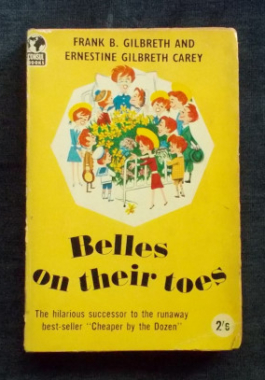 Life is very different now in the rambling Gilbreth house.When the youngest was two and the oldest eighteen, Dad died and Mother bravely took over his business. Now, to keep the family together, everyone has to pitch in and pinch pennies. The resourceful clan rises to every crisis with a marvelous sense of fun - whether it's battling chicken pox, giving the boot to an unwelcome boyfriend, or even meeting the President. And the few distasteful things they can't overcome - like castor oil - they swallow with good humor and good grace. Belles on Their Toes is the entertaining sequel to Cheaper by the Dozen.
Life is very different now in the rambling Gilbreth house.When the youngest was two and the oldest eighteen, Dad died and Mother bravely took over his business. Now, to keep the family together, everyone has to pitch in and pinch pennies. The resourceful clan rises to every crisis with a marvelous sense of fun - whether it's battling chicken pox, giving the boot to an unwelcome boyfriend, or even meeting the President. And the few distasteful things they can't overcome - like castor oil - they swallow with good humor and good grace. Belles on Their Toes is the entertaining sequel to Cheaper by the Dozen. -

 The sequel to Cheaper By The Dozen. The true story of life - now very different - in the rambling Gilbreth house. When the youngest was two and the oldest eighteen, Dad died and Mother bravely took over their efficiency advisory business - helping factories fine-tune their assembly lines for maximum output at minimum cost. With Dad gone, everyone has to pitch in and pinch pennies to keep the family together. The resourceful clan rises to every crisis - whether it's battling chicken pox, giving the boot to an unwelcome boyfriend, or even meeting the President. And the few distasteful things they can't overcome - like the dreaded castor oil - they swallow with good humor and good grace.
The sequel to Cheaper By The Dozen. The true story of life - now very different - in the rambling Gilbreth house. When the youngest was two and the oldest eighteen, Dad died and Mother bravely took over their efficiency advisory business - helping factories fine-tune their assembly lines for maximum output at minimum cost. With Dad gone, everyone has to pitch in and pinch pennies to keep the family together. The resourceful clan rises to every crisis - whether it's battling chicken pox, giving the boot to an unwelcome boyfriend, or even meeting the President. And the few distasteful things they can't overcome - like the dreaded castor oil - they swallow with good humor and good grace. -
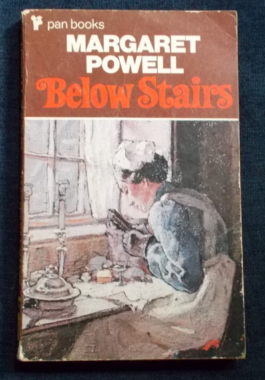 These are the REAL below-stairs stories from the time of servants, lords, ladies and the great divide between Upstairs and Downstairs. Margaret Powell - shrewd, unabashed and wickedly funny - was originally interviewed on radio in the late sixties to talk about her life as a servant and the response was so intense that it spawned a series of books of her experiences. Read about the household where she had to iron the bootlaces; the guest who kept hot potatoes in her cleavage...not to mention the gentleman who like to stroke the housemaid's curlers (!). You couldn't invent these stories.
These are the REAL below-stairs stories from the time of servants, lords, ladies and the great divide between Upstairs and Downstairs. Margaret Powell - shrewd, unabashed and wickedly funny - was originally interviewed on radio in the late sixties to talk about her life as a servant and the response was so intense that it spawned a series of books of her experiences. Read about the household where she had to iron the bootlaces; the guest who kept hot potatoes in her cleavage...not to mention the gentleman who like to stroke the housemaid's curlers (!). You couldn't invent these stories. -

Bess: Anna Beer
$15.00Walter Raleigh symbolises the Elizabethan world, but what of his wife, Bess? She had her own remarkable story. She played for high political stakes in a dangerous and violent world - and successive monarchs, threatened by her ability, sought to destroy her and those she loved. She lost her husband and two of her three children and herself was imprisoned, interrogated, banished and made destitute. Yet each time she came back, taking on her enemies with a resilience and courage remarkable for her time. Portrait on dustjacket © National Gallery of Ireland. -
 Though she owed everything to her supportive mother Ruthie, Bette Davis remained fascinated all her life with her hard-to-please father, who walked out on his family when she was still a little girl. She could never forget the disappointment in his lack of interest and believed that her resentment toward him was a factor in her four failed marriages. Bette's distinctive voice, remarkable eyes and astonishing range of characterisation all combined to make her one of the finest performers in film history. Drawing on extensive conversations with Bette over the last decade of her life, Chandler brings Bette to life as a dynamic forceful presence - whether as Jezebel the Southern beauty or plain Aunt Charlotte of Now, Voyager. There''s a few myths and legends debunked and some fabulous snippets revealed - such as she did her own make up for Whatever Happened To Baby Jane and literally scared herself. Chandler also spoke with directors, actors, and others who knew and worked with Davis, and includes brief synopses of all of her films. Illustrated with photographs.
Though she owed everything to her supportive mother Ruthie, Bette Davis remained fascinated all her life with her hard-to-please father, who walked out on his family when she was still a little girl. She could never forget the disappointment in his lack of interest and believed that her resentment toward him was a factor in her four failed marriages. Bette's distinctive voice, remarkable eyes and astonishing range of characterisation all combined to make her one of the finest performers in film history. Drawing on extensive conversations with Bette over the last decade of her life, Chandler brings Bette to life as a dynamic forceful presence - whether as Jezebel the Southern beauty or plain Aunt Charlotte of Now, Voyager. There''s a few myths and legends debunked and some fabulous snippets revealed - such as she did her own make up for Whatever Happened To Baby Jane and literally scared herself. Chandler also spoke with directors, actors, and others who knew and worked with Davis, and includes brief synopses of all of her films. Illustrated with photographs. -
 In 1982, teenager Andrew Tregurtha pleaded guilty to the murder of the Greek Consul-General and a teacher in Sydney's inner city. Six years later he committed suicide at Berrima Gaol. Between the hours of dark and daylight, the lonely hours when prisoners are locked in their cells, Andrew hanged himself. This is his own story. Tregurtha's confession confession begins with the difficulty his family experienced dealing with his undiagnosed hyperactivity and dyslexia, the ensuing confrontations with education authorities and his move to King's Cross as a fifteen year old. Here, unbeknown to his parents, he worked as a male prostitute, eventually falling under the influence of Michael Caldwell, who introduced him to the world of crime in the city. He was sixteen when he was arrested for murder. It is a harrowing tale of life on the edge, of a waif at the Cross, written simply and unglamorously, as he worked towards self-understanding and rehabilitation. Andrew too his own life before publication. Illustrated with black and white photographs.
In 1982, teenager Andrew Tregurtha pleaded guilty to the murder of the Greek Consul-General and a teacher in Sydney's inner city. Six years later he committed suicide at Berrima Gaol. Between the hours of dark and daylight, the lonely hours when prisoners are locked in their cells, Andrew hanged himself. This is his own story. Tregurtha's confession confession begins with the difficulty his family experienced dealing with his undiagnosed hyperactivity and dyslexia, the ensuing confrontations with education authorities and his move to King's Cross as a fifteen year old. Here, unbeknown to his parents, he worked as a male prostitute, eventually falling under the influence of Michael Caldwell, who introduced him to the world of crime in the city. He was sixteen when he was arrested for murder. It is a harrowing tale of life on the edge, of a waif at the Cross, written simply and unglamorously, as he worked towards self-understanding and rehabilitation. Andrew too his own life before publication. Illustrated with black and white photographs. -
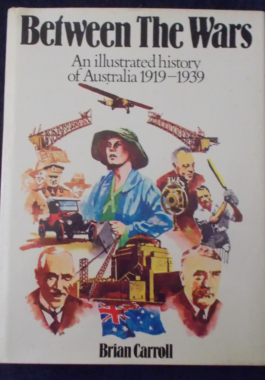 The era between the wars was one of prosperity. The Roaring Twenties saw the development of the film and radio industries. Australia could boast of having the best cricketers and arguably, the best racehorse. But it would not last. The collapse of the stock market heralded the worldwide Depression and by the time the economy recovered, another generation of young men were enlisting for war. Carroll traces the major themes of Australian life over the decades of prosperity and penury. Illustrated with black and white photographs
The era between the wars was one of prosperity. The Roaring Twenties saw the development of the film and radio industries. Australia could boast of having the best cricketers and arguably, the best racehorse. But it would not last. The collapse of the stock market heralded the worldwide Depression and by the time the economy recovered, another generation of young men were enlisting for war. Carroll traces the major themes of Australian life over the decades of prosperity and penury. Illustrated with black and white photographs -
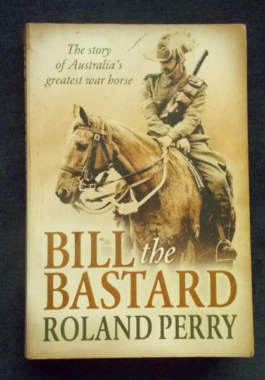 Bill was massive. He had power, intelligence and unmatched courage. In performance and character, he stood above all the other 200,000 Australian horses sent to the Middle East in the Great War. But as war horses go, he had one serious problem. No one could ride him but one man, Major Michael Shanahan. Some even thought Bill took a sneering pleasure in watching would-be riders hit the dust. This is a remarkable tale of a bond between a determined trooper and his stoic but cantankerous mount. They fought together. They depended on each other for survival. And when the chips were down, Bill's heroic efforts and exceptional instincts in battle saved the lives of Shanahan and four of his men. By September 1918, 'Bill the Bastard' was known by the entire Light Horse regiment, who used his name not as an insult, but as a term of endearment. Bill had become a legend, a symbol of the courage and unbreakable will of the Anzac mounted force. There was no other horse like Bill the Bastard.
Bill was massive. He had power, intelligence and unmatched courage. In performance and character, he stood above all the other 200,000 Australian horses sent to the Middle East in the Great War. But as war horses go, he had one serious problem. No one could ride him but one man, Major Michael Shanahan. Some even thought Bill took a sneering pleasure in watching would-be riders hit the dust. This is a remarkable tale of a bond between a determined trooper and his stoic but cantankerous mount. They fought together. They depended on each other for survival. And when the chips were down, Bill's heroic efforts and exceptional instincts in battle saved the lives of Shanahan and four of his men. By September 1918, 'Bill the Bastard' was known by the entire Light Horse regiment, who used his name not as an insult, but as a term of endearment. Bill had become a legend, a symbol of the courage and unbreakable will of the Anzac mounted force. There was no other horse like Bill the Bastard. -
 Referred to as 'the dean of American decorators', it seemed that Billy was always marked for success. His Aunt Olivia claimed that he even had charm in his crib. His autobiography has the same personal charm, with an unerring eye for detail and a wickedly sensitive ear. He created beautiful environments for fascinating people for over 40 years. He was always in the limelight and could count among his friends luminaries such as Cole Porter, Great Garbo, Pauline de Rothschild, Jacqueline Onassis and the Duke and Duchess of Windsor. He saw life as a celebration and in his autobiography has given the reader an intimate look at a great professional and a collection of mischievous tales about some of the most fashionable and envied celebrities of his day. Illustrated with black and white photographs.
Referred to as 'the dean of American decorators', it seemed that Billy was always marked for success. His Aunt Olivia claimed that he even had charm in his crib. His autobiography has the same personal charm, with an unerring eye for detail and a wickedly sensitive ear. He created beautiful environments for fascinating people for over 40 years. He was always in the limelight and could count among his friends luminaries such as Cole Porter, Great Garbo, Pauline de Rothschild, Jacqueline Onassis and the Duke and Duchess of Windsor. He saw life as a celebration and in his autobiography has given the reader an intimate look at a great professional and a collection of mischievous tales about some of the most fashionable and envied celebrities of his day. Illustrated with black and white photographs. -

Billy: Pamela Stephenson
$7.00Once in a lifetime, there strides upon the stage someone who can truly be called a legend. Such a person is the inimitable, timeless genius who is Billy Connolly. His effortlessly wicked whimsy has entranced, enthralled – and split the sides of – thousands upon thousands of adoring audiences. And when he isn't doing that…he's turning in award-winning performances on film and television. He's the man who needs no introduction, and yet he is the ultimate enigma. From a troubled and desperately poor childhood in the docklands of Glasgow he is now the intimate of household names the world over. How did this happen, who is the real Billy Connolly? Only one person can answer that question: his wife, Pamela Stephenson. Pamela’s writing combines the very personal with a frank objectivity that makes for a compelling, moving and hugely entertaining biography. This is the real Billy Connolly. -
 At the time of publication, Black Saturday was Australia's worst national disaster with 210 dead and others perhaps still missing. Over 1800 homes were destroyed along with hopes and dreams of a peaceful community living in the leafy hills on Melbourne's fringes. Black Saturday is a tale of everyday people who, when fate demanded, became heroes. In Kinglake, Peter Thorneycroft stood defiantly in shorts and thongs hosing down the roof of the local pub where 20 women and children sheltered inside. This book is the personal story of Black Saturday told by those that survived the flames and those who came to their help. It also contains accounts from journalists who covered the fires as well as first-hand tales from those who helped co-ordinate the emergency response. Black and white photographs.
At the time of publication, Black Saturday was Australia's worst national disaster with 210 dead and others perhaps still missing. Over 1800 homes were destroyed along with hopes and dreams of a peaceful community living in the leafy hills on Melbourne's fringes. Black Saturday is a tale of everyday people who, when fate demanded, became heroes. In Kinglake, Peter Thorneycroft stood defiantly in shorts and thongs hosing down the roof of the local pub where 20 women and children sheltered inside. This book is the personal story of Black Saturday told by those that survived the flames and those who came to their help. It also contains accounts from journalists who covered the fires as well as first-hand tales from those who helped co-ordinate the emergency response. Black and white photographs. -
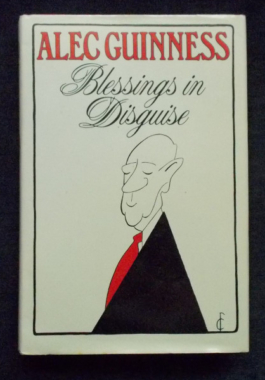 This is not a tell-all exercise in egomania - rather, it is a witty, entertaining account of the people Alec Guiness knew and often worked with, caught for posterity in brilliant pen portraits. The reader will meet Ralph Richardson, Sybil Thorndike, Tyrone Guthrie and John Geilgud. Edith Sitwell presides at the Sesame Club and reconciled to the Catholic Church, and for the occasion Evelyn Waugh dressed in black and white dog-tooth tweeds, a red tie and a boater with red and blue ribbons; Vivien Leigh charms a susceptible admiral in North Africa; Ernest Hemingway is underwhelmed by Noel Coward; and of course, Alex Guinness himself - on his film career, religious beliefs and war experiences, told with modesty, timing, humour and humanity.
This is not a tell-all exercise in egomania - rather, it is a witty, entertaining account of the people Alec Guiness knew and often worked with, caught for posterity in brilliant pen portraits. The reader will meet Ralph Richardson, Sybil Thorndike, Tyrone Guthrie and John Geilgud. Edith Sitwell presides at the Sesame Club and reconciled to the Catholic Church, and for the occasion Evelyn Waugh dressed in black and white dog-tooth tweeds, a red tie and a boater with red and blue ribbons; Vivien Leigh charms a susceptible admiral in North Africa; Ernest Hemingway is underwhelmed by Noel Coward; and of course, Alex Guinness himself - on his film career, religious beliefs and war experiences, told with modesty, timing, humour and humanity. -

Bluey: Harold Lewis
$12.00The sequel to Crow On A Barbed Wire Fence. Bluey's adventures did not end with his departure from Australia in 1914. In this sequel he tells of his London childhood and why he visited Australia in the first place. There's also the tale of his escape from the German naval fleet in World War I, his role in two mutinies and the headline stories he reported as a Fleet Street journo, sportswriter and radio interviewer. Last but not least, he tells of his family life and his achievements as a successful magazine publisher - what a full, rich and adventurous life!
-
 Kenneth Williams was the stand-out comic actor of his generation. Beloved as the manic star of Carry On films and as a peerless raconteur on TV chat shows, he was also acclaimed for serious stage roles. This volume includes much previously unseen material from Williams's candid daily journal and also draw on rare in-depth interviews with friends and colleagues. Since the publication of edited extracts from his diaries, much controversy has surrounded Williams's personal and professional lives. It's a a sympathetic, if critical, view - Williams was frequently exasperatingly difficult, rude and inconsiderate - yet the author shows, again and again, how valued and treasured Kenneth Williams was and shows him in the round - from his kindness and generosity to the time when he could be quite spiteful. This biography traces the complex contradictions that characterised an extraordinary life and presents the first full portrait of a star who was born brilliant. Illustrated with photographs.
Kenneth Williams was the stand-out comic actor of his generation. Beloved as the manic star of Carry On films and as a peerless raconteur on TV chat shows, he was also acclaimed for serious stage roles. This volume includes much previously unseen material from Williams's candid daily journal and also draw on rare in-depth interviews with friends and colleagues. Since the publication of edited extracts from his diaries, much controversy has surrounded Williams's personal and professional lives. It's a a sympathetic, if critical, view - Williams was frequently exasperatingly difficult, rude and inconsiderate - yet the author shows, again and again, how valued and treasured Kenneth Williams was and shows him in the round - from his kindness and generosity to the time when he could be quite spiteful. This biography traces the complex contradictions that characterised an extraordinary life and presents the first full portrait of a star who was born brilliant. Illustrated with photographs. -
 The son of W.E. (Bill) Harney, the legendary writer and story-teller and Ludi Yibuluyma, a Waradaman woman, Yidumduma Bill Harney had little contact with his father. Instead, he was brought up straddling both heritages learning the traditional Aboriginal way of of life and the white man's way. Yidumduma Bill witnessed horrific acts such as cattle station owners poisoning Aborigines and welfare officers seizing part-Aboriginal children. His own sister Dulcie was taken by the authorities and he narrowly escaped the same fate. Years later, he had to fight to keep his own sons. Bill has seen the disintegration of the traditional Aboriginal way of life and the end of the livelihood of stockmen and drovers. Shocking stories of casual cruelty and violence sit alongside the tales of the Dreamtime, graphic details of the bush tucker of his childhood and hilarious yarns about drunken drovers, crafty poddy-dodgers and miserable publicans.
The son of W.E. (Bill) Harney, the legendary writer and story-teller and Ludi Yibuluyma, a Waradaman woman, Yidumduma Bill Harney had little contact with his father. Instead, he was brought up straddling both heritages learning the traditional Aboriginal way of of life and the white man's way. Yidumduma Bill witnessed horrific acts such as cattle station owners poisoning Aborigines and welfare officers seizing part-Aboriginal children. His own sister Dulcie was taken by the authorities and he narrowly escaped the same fate. Years later, he had to fight to keep his own sons. Bill has seen the disintegration of the traditional Aboriginal way of life and the end of the livelihood of stockmen and drovers. Shocking stories of casual cruelty and violence sit alongside the tales of the Dreamtime, graphic details of the bush tucker of his childhood and hilarious yarns about drunken drovers, crafty poddy-dodgers and miserable publicans. -
 Bill Monroe, legend of early country music and bluegrass; and Muddy Waters, iconic Chicago bluesman, tell their story in their own words as the author contrasts their remarkably similar careers. More than just a book about music, it is a book about the time of black and white America, a microcosmic history that sets up striking comparisons. Illustrated with black and white photographs.
Bill Monroe, legend of early country music and bluegrass; and Muddy Waters, iconic Chicago bluesman, tell their story in their own words as the author contrasts their remarkably similar careers. More than just a book about music, it is a book about the time of black and white America, a microcosmic history that sets up striking comparisons. Illustrated with black and white photographs. -
 In 1762 James Boswell, then twenty-two years old, left Edinburgh for London. The famous Journal he kept during the next nine months is an intimate account of his encounters with the high-life and the low-life in London. Frank and confessional as a personal portrait of the young Boswell, the Journal is also revealing as a vivid portrayal of life in eighteenth-century London. This new edition includes an introduction by Peter Ackroyd, which discusses Boswell’s life and achievement. From the introduction: Boswell was the most charming companion in the world, and London becomes his dining-room and his playground, his club and his confessional. No celebrant of the London world can ignore his book.
In 1762 James Boswell, then twenty-two years old, left Edinburgh for London. The famous Journal he kept during the next nine months is an intimate account of his encounters with the high-life and the low-life in London. Frank and confessional as a personal portrait of the young Boswell, the Journal is also revealing as a vivid portrayal of life in eighteenth-century London. This new edition includes an introduction by Peter Ackroyd, which discusses Boswell’s life and achievement. From the introduction: Boswell was the most charming companion in the world, and London becomes his dining-room and his playground, his club and his confessional. No celebrant of the London world can ignore his book. -
 James Boswell's The Life of Samuel Johnson is the most celebrated of all biographies, acknowledged as one of the greatest and most entertaining books in the English language. Yet Boswell himself has generally been considered little more than an idiot and condemned by posterity as a lecher and drunk. How could such a fool have written such a book? With great wit, Sisman tells the story of Boswell's presumptuous task - the making of the greatest biography of all time by tracing the friendship between Boswell and Samuel Johnson, his great mentor, and provides a fascinating account of Boswell's seven-year struggle to write The Life of Samuel Johnson.
James Boswell's The Life of Samuel Johnson is the most celebrated of all biographies, acknowledged as one of the greatest and most entertaining books in the English language. Yet Boswell himself has generally been considered little more than an idiot and condemned by posterity as a lecher and drunk. How could such a fool have written such a book? With great wit, Sisman tells the story of Boswell's presumptuous task - the making of the greatest biography of all time by tracing the friendship between Boswell and Samuel Johnson, his great mentor, and provides a fascinating account of Boswell's seven-year struggle to write The Life of Samuel Johnson. -
 An informative A-Z guide to every aspect of the silver screen, which takes in biographies of film stars and directors, accounts of films from all parts of the world, articles on the history of cinema and explanations of technical terms and film makers' jargon. It explores the myths and legends of cinema, giving insights into famous successes, disasters and scandals. With a foreword by Richard Attenborough.
An informative A-Z guide to every aspect of the silver screen, which takes in biographies of film stars and directors, accounts of films from all parts of the world, articles on the history of cinema and explanations of technical terms and film makers' jargon. It explores the myths and legends of cinema, giving insights into famous successes, disasters and scandals. With a foreword by Richard Attenborough. -
 The first edition of Dr. Ebenezer Cobham Brewer's Dictionary of Phrase and Fable was published in 1870. Subsequent editions of the original volume have been made throughout the times since, the 15th being published in 1995, to take account of new research and new words entering the language. The linguistic developments of the 20th century, however, have been so rapid and voluminous that a wholly 20th century edition was needed. This was first published in 1991 and, taking its cue from Dr. Brewer's wide-ranging and informed approach, set out to record the language that defines the contemporary age, reflecting all aspects of 20th century life and culture in over 8000 entries, ranging from Abominable Snowman to Zoo Daddy.
The first edition of Dr. Ebenezer Cobham Brewer's Dictionary of Phrase and Fable was published in 1870. Subsequent editions of the original volume have been made throughout the times since, the 15th being published in 1995, to take account of new research and new words entering the language. The linguistic developments of the 20th century, however, have been so rapid and voluminous that a wholly 20th century edition was needed. This was first published in 1991 and, taking its cue from Dr. Brewer's wide-ranging and informed approach, set out to record the language that defines the contemporary age, reflecting all aspects of 20th century life and culture in over 8000 entries, ranging from Abominable Snowman to Zoo Daddy. -
 First published in 1870, this 15th edition of Dr. Brewer's dictionary has been revised and updated whilst retaining as much of the original Brewer' flavour' as possible. The editor admits to a little rewording and of course, updating of dates and figures where necessary. There's metaphors and sayings, special days and their origins, popes and royal lines...plenty here for the trivia buff or potential TV quiz kid.
First published in 1870, this 15th edition of Dr. Brewer's dictionary has been revised and updated whilst retaining as much of the original Brewer' flavour' as possible. The editor admits to a little rewording and of course, updating of dates and figures where necessary. There's metaphors and sayings, special days and their origins, popes and royal lines...plenty here for the trivia buff or potential TV quiz kid.



